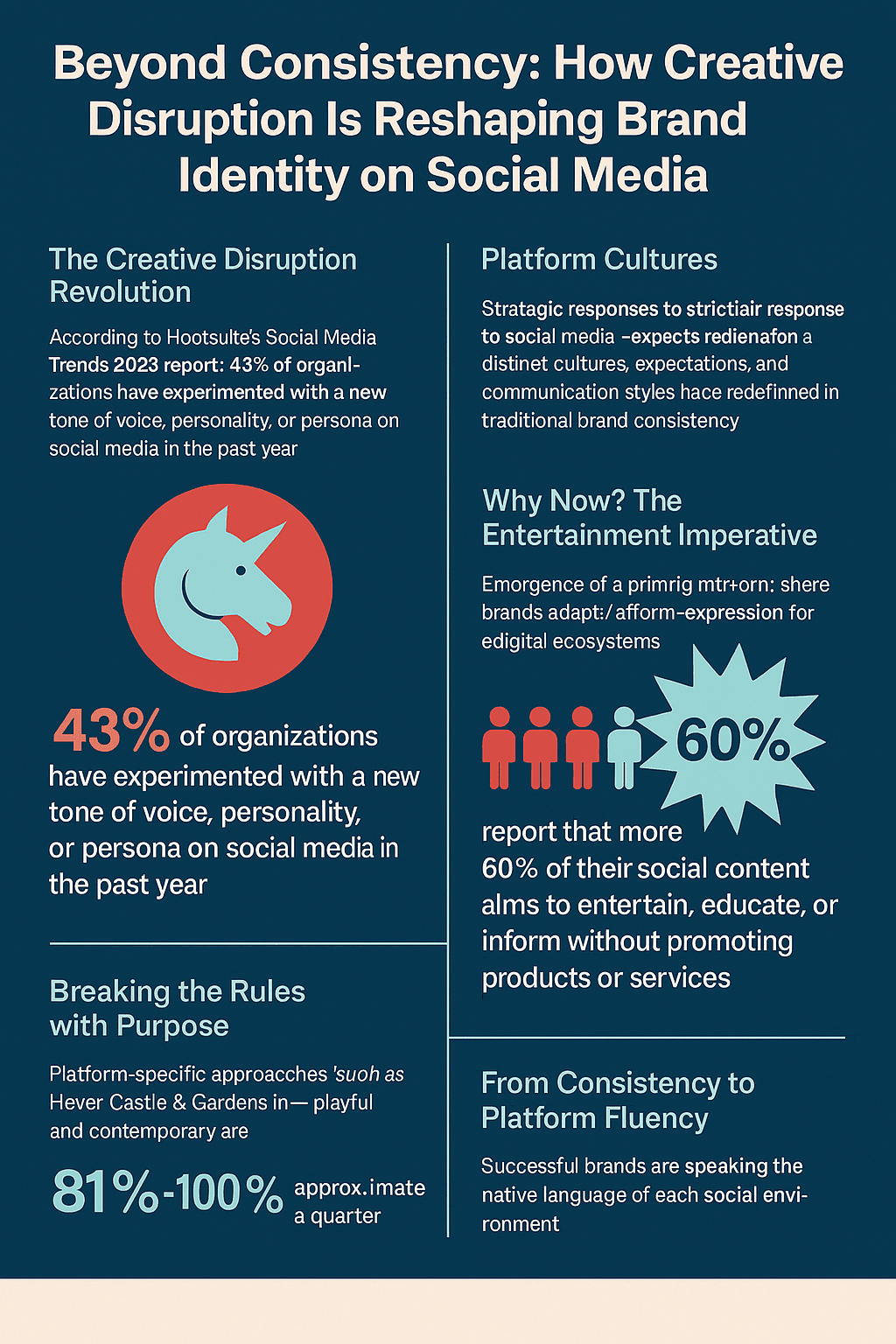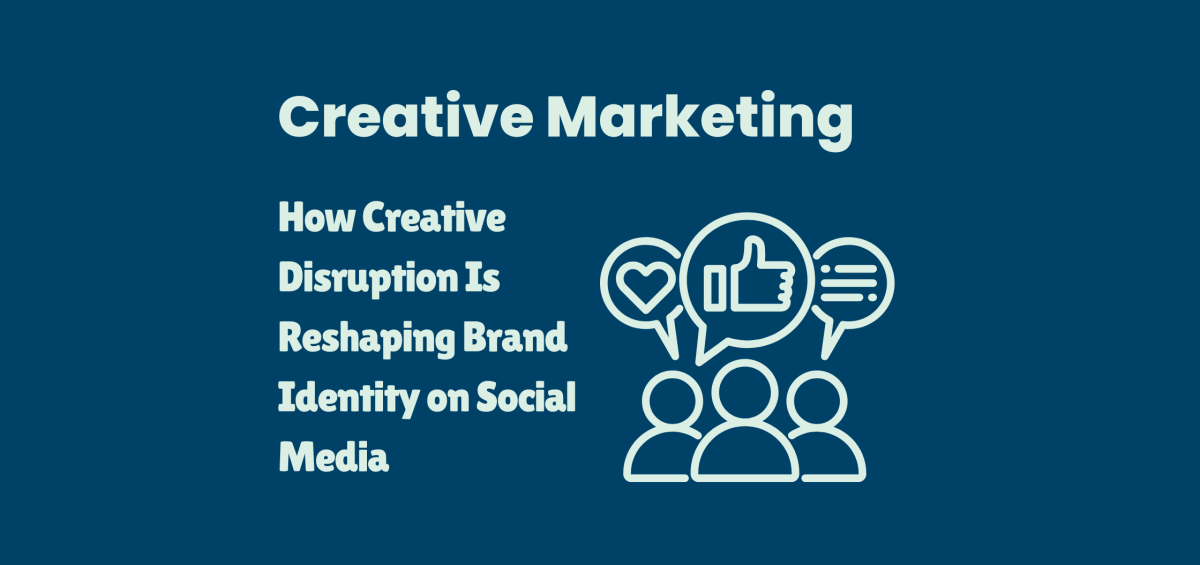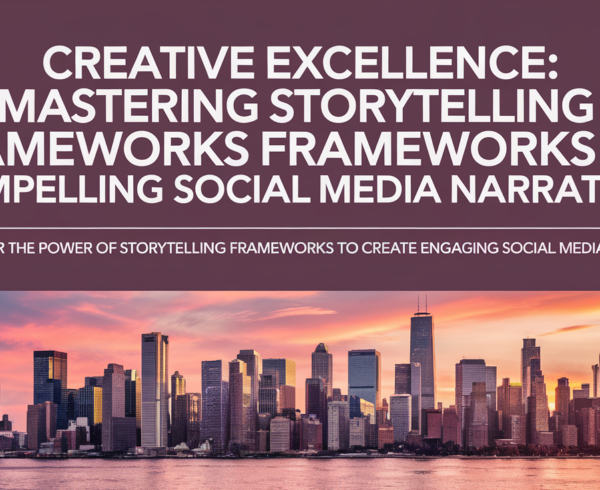Beyond Consistency: How Creative Disruption Is Reshaping Brand Identity on Social Media
For decades, the marketing mantra has been clear: consistency is king. Brand guidelines were treated as sacred texts, with rigid rules governing everything from logo placement to tone of voice. The conventional wisdom warned that any deviation could weaken brand recognition and confuse your audience.
But something fascinating is happening in the social media landscape of 2025: the most successful brands are breaking these long-established rules, and they’re thriving because of it.
The Creative Disruption Revolution
According to Hootsuite’s Social Media Trends 2025 report, 43% of organizations have experimented with a new tone of voice, personality, or persona on social media in the past year. What’s more surprising is that the most adventurous brands have developed social personas so distinct that their content barely resembles their brand personality on other marketing channels.
This isn’t just rebellion for rebellion’s sake. It’s a strategic response to a fundamental truth about social media: these platforms each have their own distinct cultures, expectations, and communication styles. The brands that are winning aren’t trying to bend these platform cultures to fit their brand guidelines—they’re adapting their brand expression to fit naturally within these digital ecosystems.
Leading Content Marketing Agency experts confirm this shift, noting that traditional approaches to brand consistency are being redefined by the need for platform-specific authenticity.
Why Now? The Entertainment Imperative
The shift toward creative disruption isn’t happening in isolation. It’s directly connected to another critical trend: the entertainment imperative. Last year, Hootsuite’s research revealed that above all else, social media users want to be entertained. But brands weren’t meeting these expectations, and they struggled to demonstrate ROI as a result.
Fast forward to today, and organizations have stepped up their game significantly. Nearly half of survey respondents report that more than 60% of their social content aims to entertain, educate, or inform without directly promoting their products or services.
Even more striking is the emergence of what Hootsuite calls “Creative Risk-Takers”—brands where a whopping 81% to 100% of content is entertainment-driven. These brands represent approximately a quarter of organizations, and they’re setting a new standard for social media creativity.
In trend-forward markets like Social Media Singapore, we’re seeing this approach take hold even faster, with brands embracing platform-specific expression to connect with diverse, digitally-savvy audiences.
Case Study: Breaking the Rules with Purpose
Consider Hever Castle & Gardens, a historic attraction in the UK. A quick comparison between their Instagram feed and their website reveals two distinctly different brand personalities. While their website maintains a more traditional, informative tone befitting a historical landmark, their Instagram presence is playful, contemporary, and deeply engaged with current social trends.
Similarly, the Royal Society for the Protection of Birds (RSPB) has created TikTok content that diverges significantly from their more formal web presence. On TikTok, they’ve embraced humor, trendy audio, and casual language that resonates with younger audiences—without compromising their conservation message.
Both organizations understand something crucial: different platforms require different approaches, and what works on your website won’t necessarily translate to TikTok, Instagram, or LinkedIn.
This principle is especially relevant in competitive markets like Singapore, where any Social Media Agency worth its salt is advising clients to adopt platform-specific strategies rather than one-size-fits-all approaches.
From Consistency to Platform Fluency
What these brands have discovered is that the goal shouldn’t be rigid consistency across all touchpoints but rather platform fluency—the ability to speak the native language of each social environment while maintaining the core essence of your brand.
Think of it like international business: a successful global company doesn’t use identical approaches in every market. They adapt their messaging, offerings, and sometimes even their products to align with local cultures and preferences. The principle is the same for social platforms.
The most successful brands have identified their non-negotiable brand elements—the core values and distinctive attributes that truly define them—while allowing flexibility in how these elements are expressed across different channels.
Content Marketing strategies are evolving to embrace this fluidity, with brands creating platform-specific content that feels native to each environment while still reinforcing core brand values.
The Business Case for Creative Risk-Taking
For leaders who prioritize metrics and ROI (which should be all of us), the idea of loosening brand guidelines might seem risky. But the data suggests otherwise.
Hootsuite’s research found that social marketers who consistently post creative content on social are more likely to report having a very positive impact on the business compared to those who post creative content less frequently. When social professionals can confidently say their efforts are paying off, it’s a strong indicator that their audiences are responding positively.
Carahsoft, a Virginia-based IT solutions provider for the public sector, offers a compelling example. When they began experimenting with more creative content on their main social channels—particularly showcasing their people at networking events and conferences—they saw impressions jump from their usual 500 to around 7,000. Re-shares skyrocketed, resulting in a surge in event signups and leads.
“Getting executive buy-in is key,” says Elizabeth Slaughter, Social Media Manager at Carahsoft. “And it’s been a lot easier recently because we’ve really gone the extra mile to show what’s working.”
Finding Your Brand’s Creative Balance
Creative disruption doesn’t mean abandoning all guidelines or going completely “unhinged” with your social content. Even the boldest brands maintain some level of consistency in their creative experimentation.
The key is finding the right balance for your specific brand and audience. This requires honest conversations with stakeholders about:
- What’s truly non-negotiable: Which elements of your brand identity are fundamental to who you are? These might include core values, brand purpose, or specific visual elements that have strong recognition value.
- What can be flexible: Which elements can evolve or be expressed differently across platforms without compromising your brand essence?
- Where the opportunities lie: Which platforms would benefit most from a more platform-native approach to content? Where are your audiences most receptive to different types of content?
This balancing act is something that any experienced Influencer Marketing Agency Singapore understands intimately, as they constantly navigate the tension between brand guidelines and influencer authenticity.
Four Steps to Creative Disruption
If you’re convinced that your brand could benefit from more creative flexibility on social media, here’s a four-step approach to get started:
1. Unlock Your Brand Handcuffs (But Don’t Throw Away the Key)
Even when you’re trying to deviate from your usual playbook, every brand has its non-negotiables. Get all relevant marketing teams and leaders together to do a thorough review of your brand guidelines. Collectively decide what you’re willing to let go of and what you’re not.
Don’t be discouraged if you end up with more limitations than you’d like—sometimes having guardrails can actually spark creativity, not stifle it. The key is to be intentional about where you’re creating flexibility.
2. Start Small with Platform-Specific Experiments
Rather than overhauling your entire social presence at once, choose one platform where your current approach feels most disconnected from the platform’s culture. Consider running a limited experiment with a different tone, visual style, or content approach for a defined period.
Document your baseline metrics before the experiment, then track performance carefully throughout. Look not just at engagement metrics but also at sentiment, audience growth, and any conversion metrics relevant to your business goals.
3. Have a Plan for Measuring Success
Debuting a new(ish) personality on social media calls for new objectives and new metrics for measuring success—because they can (and should) be different from your typical set.
This could be a great opportunity to bring back those “vanity metrics” you previously dropped, since engagement can be very telling when you’re testing creative approaches. Sentiment should also top your list of KPIs, and social listening can help you track how your audience feels about your jazzed-up content in real time.
4. Get Your Boss on Board
For leaders who care about numbers (and dollar signs) more than anything else, testing out bolder content that may not generate quick wins can feel like scary territory. But remember that customer acquisition matters—and following a brand on social does impact purchasing decisions, according to Hootsuite’s latest Social Media Consumer Report.
That’s a real juicy data point to lean on to get buy-in. The equation is simple: More engaging content = new followers = new potential customers = revenue growth.
This is particularly true in competitive markets like Singapore, where standing out requires a willingness to push creative boundaries.
Looking Ahead: What’s Next for Brand Expression on Social
In 2025, we’re seeing more organizations step outside their creative comfort zones and test content that pushes beyond their brand guidelines to capture new audiences (and delight current ones). Organizations that have already taken this first step are using their learnings to expand their experimentation to more platforms and other areas of their social strategy, like paid social, employee advocacy, and executive thought leadership.
This trend is likely to continue accelerating, with brands developing increasingly distinct platform personas while maintaining a coherent overall brand identity. The most successful will find ways to let their creativity shine while still delivering on their core brand promise.
As social platforms continue to evolve and fragment, with each developing its own increasingly distinct culture, the pressure to adapt will only grow. Brands that can balance creative flexibility with strategic consistency will be the ones that thrive.
Finding Your Creative Edge
The shift away from rigid brand consistency doesn’t mean abandoning guidelines altogether. Instead, it means adopting a more nuanced, platform-specific approach to brand expression that honors the unique culture and expectations of each social environment.
As you consider how to apply creative disruption to your own social strategy, ask yourself:
- Which platform cultures feel most disconnected from our current brand expression?
- What aspects of our brand could be expressed differently while maintaining our core identity?
- How might we experiment with different tones, visual styles, or content approaches while still delivering on our brand promise?
- What guard rails do we need to put in place to ensure our experimentation enhances rather than dilutes our brand?
Working with specialized partners like an Influencer Marketing Agency Singapore can provide valuable insights into how to balance brand authenticity with platform-specific creativity.
The most successful brands in the creative disruption era aren’t abandoning their identity—they’re finding new, platform-specific ways to express it that resonate more deeply with their audiences. They’re trading rigid consistency for authentic connection, and they’re being rewarded with stronger engagement, growing audiences, and measurable business results.
In a social landscape where users increasingly expect to be entertained, educated, and engaged, creative disruption isn’t just a trend—it’s becoming a necessity for brands that want to stay relevant and effective, especially in dynamic markets like Social Media Singapore.
The question isn’t whether your brand should embrace more creative flexibility on social media, but how to do it in a way that enhances rather than dilutes your brand identity. By starting with a clear understanding of your core brand elements, experimenting thoughtfully, measuring carefully, and getting key stakeholders on board, you can find the right balance of consistency and creativity for your unique brand and audience.
In the end, the most successful social brands won’t be the ones with the most rigid guidelines—they’ll be the ones that can adapt and evolve while staying true to who they are at their core. They’ll be dancing in the whirlwind, as Hootsuite puts it, with both authenticity and agility.
Is your brand ready to disrupt creatively?







